
| There
is so much diversity in China that there is no way I can even pretend to
understand her history, culture, beauty and her people. While I visited
many places and have around one thousand slides documenting my trip of
2002, I decided to share only some of my impressions and/or descriptions
of the selected sites in no particular order. Please remember, the following
is not, by any means, a guide or an account of my numerous adventures in
China: for both I would need to write a book.
Have
fun browsing through this section of my website and let me know (mruczek@aol.com)
if you have any comments!

|
..... |
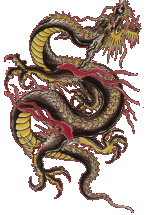 |


Interactive
map of China
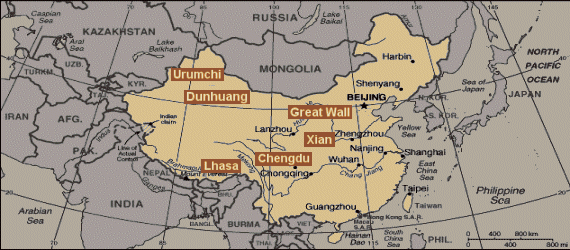
This
is an interactive map with the sites described in this presentation. If
you want to visit them, please click on a selected name and enjoy your
trip!

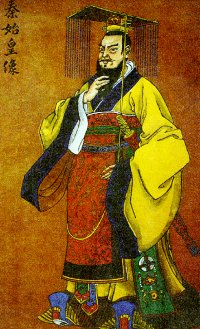 |
     |
One
of the Seven Wonders of the world, the Great Wall, stretches over 6,700
km crossing mountains, deserts, grasslands and plateaus from eastern China
to as far as Lop Nur in the West. While its best preserved sections from
the Ming Dynasty (1368-1644) are admired by thousands of tourists marveling
every day at their size (at average: 10 m high and 5 m wide), not many
realize that its construction started almost two thousand years earlier.
At the beginning the Great Wall was a number of separate walls protecting
various states of China from their enemies, mostly from nomads to the North.
In 221 B.C. the Qin Dynasty emerged as the strongest power among the Warring
States (475-221 B.C.). Its emperor, who unified China (this name is derived
from the name of his Dynasty) for the first time, in 214 B.C., named himself
“The Commencing [First] Emperor,” Shi Huangdi. He is the one who is credited
with building the Great Wall although, in reality, he connected the existing
separate walls into one defensive system on the northern border. |
It
took approximately ten years to connect, construct and finish the Wall
stretching at the time from Linzhao (in the eastern part of today's Gansu
Province) in the west to Liaodong (in today's Jilin Province) in the east.
Over 300 000 soldiers plus countless conscripted laborers and convicts
in exile worked on this project under a watchful eye of General Meng Tian.
In the 6th century, almost 800 years later, over 1.8 million people were
forced to construct just a “small” section (ca. 450 km) of the Great Wall
between Nankou, Beijing, to Datong, Shanxi.
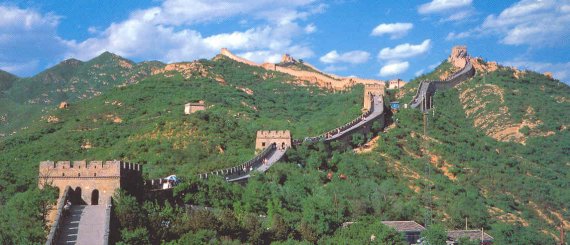
Chinese
emperors thought nothing of sending millions of their subjects to their
death. More than million laborers died with the construction of the Great
Wall. It is said that “each stone in the Great Wall cost a human life.”
The Wall was to protect China from fearless nomads, especially those known
as Hsiung-Nu who bothered China under the Qin and Han Dynasties. The Hsiung-nu
were a nomadic tribe who formed a strong confederacy located in Mongolia,
Xinjiang (China) and Kazakhstan before they were pushed westward.
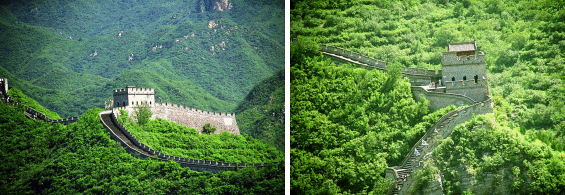
They
are believed to be of Turco-Mongolian origin and are known to the Westerns
as the Huns of the later period. In somewhat twisted way, the Hsiung-Nu
“contributed” to two main achievements of China: building the Great Wall
(against them) and establishment of the most famous international highway
of antiquity - the Silk Route (Chinese search for allies against them).
While today the Hsiung-Nu are long forgotten, the marvels of Imperial China
still attest to their power and remind us that history of China is about
continuous struggle between nomadic “barbarians” and sedentary
“civilized”
world of the Chinese Emperors.
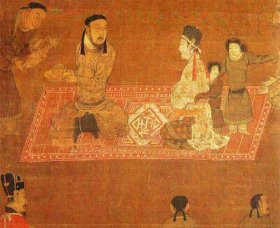 |
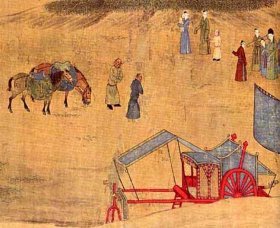 |
The
14th century Chinese presentations of the Hsiung-Nu nomads based on earlier
originals.
. |
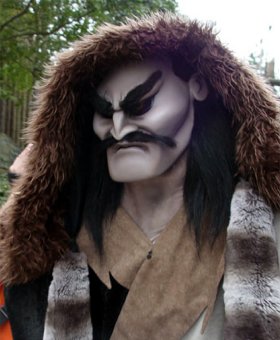 |
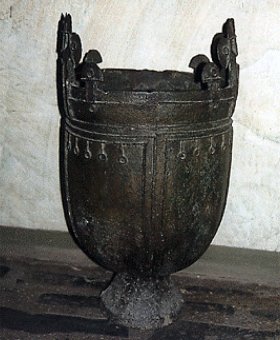 |
The
“Shan-yü” is an abbreviated title of the Hsiung-Nu leaders such as
Mo-Tun (208-175) who organized their state as a nomadic army led by two
dignitaries referred to as the kings of the right (West) and of the left
(East). |
Hsiung-nu
Cauldron, Institute of Archaeology Museum Chisinau, Moldova |
EWA’S
FUNNY STORY: BREAKING UP IN STYLE!
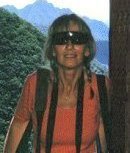 |
    |
August
2002… The Great Wall of China… Thousands of tourists were busy sweating
while climbing to the top so they could take a picture and, at least, send
a text message to those who could not be there. Little children seemed
not to have any problems jumping a few steps ahead of their parents reminding
them that old age starts much earlier than at 80. Ten steps, one click
were the order of the day. There was no time nor there was a desire to
watch other climbers while on the quest to conquer the world. However,
in this throng of faceless and desperate tourists one young couple was
impossible to miss. |
She
was a beautiful, young woman with a perfect figure nicely clothed in short
shorts with a white t-shirt accenting not only her full chest but also
smooth, gold tan of her skin. Long, dark hair cascaded on her shoulders,
revealing natural tones of blackness with each and every move she made.
Her brown eyes flashed fire at the object of her attention - her boyfriend.
He, a young man in his 20s, dark and handsome, was walking quietly, his
muscular body towering over her but avoiding any contact with his stunning
companion. She screamed, he answered, but their words disappeared in the
multilingual noise of archaeology zealots until, at the top of the wall,
she turned to him, shouting in American English: “You… you brought me here,
to China, to the top of the Great Wall just to dump me?!” He calmly replied:
“Yes!”
EWA’S
COMMENT: I must give credit to the guy… Not many men can propose in style
but breaking-up in style is unheard of! Sorry ladies, I don’t know his
phone number.
(back
to the map)

There
are only a few cities that can compete with this capital of the Shaanxi
province for a title of “the greatest city” in the world with regard to
its history, architecture, size and beauty. There are many fabulous structures
that can be admired in Xian today such as the Bell Tower, Drum Tower, Big
Goose and Little Goose Pagodas, Great Mosque etc.
The
City Walls from the Ming Dynasty built on the foundations from the Tang
Dynasty (618-907) are among the best-preserved walls of this type in China.
Since many sections are gone today one cannot walk around Xian just by
following the Walls but you should try to see as much as possible. The
Walls attest to China’s past glory but also, at times, show you poverty
of some Chinese people living in slums of the ruins - definitely something
that no government is willing to “advertise.”
The
Forest of Stone Stelas is an extraordinary exhibit of stone records of
the Chinese past from the Han Dynasty to the Qing Dynasty. Over 3000 stone
“books” are exhibited here making it the “heaviest” library in the world.
Most records are devoted to the Silk Road which had its beginning in Xian
in the 2nd c. B.C. The Museum, opened on the site of the Temple of Confucius,
is a tribute to many cultures, languages, and religions, which have constituted
the mosaic of the Chinese civilization.
However,
the purpose of my trip was to experience ancient China so I focused on
two archaeological sites described below.
Emperor
Shi Huangdi, his tomb and his "Terracotta Army".
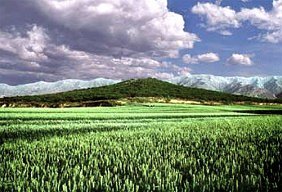 |
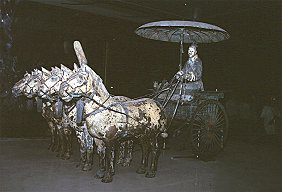 |
Xian
has witnessed the rise and fall of many Chinese dynasties governed by often
cruel rulers, the most famous (or infamous) of them being Emperor Shi Huangdi.
This probably most influential emperor of China is credited with such achievements
as standardization of the Chinese writing, taxes, and weights, “building”
the Great Wall, and constructing one of the most, if not the most, spectacular
tombs in the history of humankind. While this tomb remains mostly unexcavated
(the Terracotta Army is only a small part of the whole complex), its location
(35 km east of Xian) and description (e.g., Sima Qian, a historian in early
Han Dynasty) are well known to both archaeologists and amateurs. He ordered
its construction at the age of 13 planning to be buried there in his jade
(from Yarkand and Kotan - western China) “clothing” stitched together with
gold threads, encased in a bronze sarcophagus in the middle of the central
mercury lake. Mercury is a known mummifying agent and the best the Emperor
could do without an elixir of immortality for which he searched most of
his life. This is not just a tomb for a powerful ruler - it is a whole
underground city at his service including, as the legend goes, many of
his women, servants, officials, and a whole army; some sacrificed or buried
alive for this purpose, others “re-made” in clay.
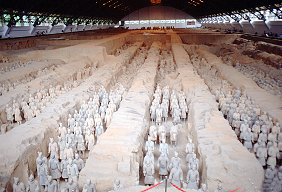 |
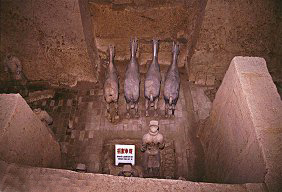 |
More
than 700,000 workers were conscripted to build the tomb, many of them were
locked inside so the mystery of its treasures and construction would be
preserved for eternity. It must be remembered that Emperor Shi Huangdi’s
enormous contributions to the development of Chinese civilization came
at terrible price paid by his subjects who were kept uneducated, tortured,
killed and/or buried alive. He burned thousands of books so they might
not get any ideas about bettering their lives and changing the regime.
He did not spend more than one night at the same place afraid of assassination
and always was guarded by the most loyal of his army, hiding away even
from his own generals. After his death, the tomb was sealed and cursed
because, as the legend says, people have been afraid that Shi Huangdi could
have found the elixir of life at the last moment and could have risen again.
Who knows, this might still be the reason why his funerary complex remains
seemingly untouched (there is a report that it was looted just 30 days
after the fall of the Qin Dynasty), in spite of its expected wealth. On
the other hand, the reason might be more pragmatic - Shi Huangdi took his
fears to his grave and in order to protect his eternity many booby traps
have been installed ready to extinguish any would-be wanderers.
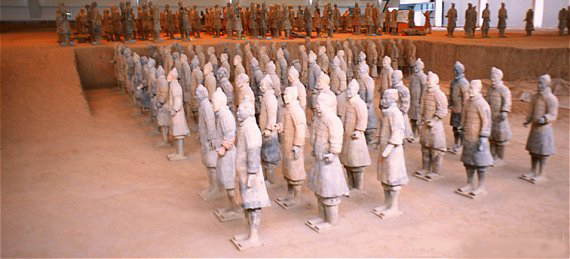
The
tomb is described as a walled city with a palace, cemetery, etc., situated
in a scale model of the Chinese empire with its mountains, lakes of mercury
and even a flowing river. The ceiling of this pyramid-shaped mound of the
tomb was designed as sky with countless pearls and precious stones arranged
in zodiac and star patterns. Illuminated by numerous lamps fed by whale
oil stored in huge tanks, the stars and planets sparkle in the darkness,
playing with their reflections in the silver waters of the imperial China.
At
the present moment only a part of Shi Huangdi’s army has been excavated
after its discovery in 1974 by local peasants digging a well. One of them
became a permanent fixture of the Terracotta Army Museum greeting visitors
in a small bookstore, signing autographs, always happy to have his picture
taken. As for the Terracotta Army … there is no way to describe how spectacular
this discovery is, how enormous in its size, and how magnificent in its
stoic glory. The people and animals seem to be sculptured in clay with
an appearance of true individuals posing for the eternity. They are arranged
in battle formations with wooden chariots and real weapons ready to defend
their Emperor. It is estimated that there are over 8000 of such terracotta
figures, many of them left intact by archaeologists under the roofs that
did not cave in under the pressure of thousands of years. In addition,
there are many other burial pits waiting for excavations. They belong to
the entourage of the Emperor, his subjects, animals, and rare birds - some
of them replicas of living beings, others buried as sacrificial tribute
to Shi Huangdi. This is one of the very few archaeological sites in the
world whose story cannot be told through pictures, movies and narrative
descriptions. This must be seen in person in order to even attempt to comprehend
the enormity and grandeur of this project.
Banpo
Neolithic Village
There
is one more place near Xian that is worth a trip, both for knowledge and
for somewhat peculiar entertainment: Banpo Neolithic Village. After seeing
other attractions of Xian this small Museum may not seem to be very impressive
with its mud houses, storage cellars, kilns, graves, pottery etc. until
one realizes its date: between 4500 and 3750 B.C.

Many
artifacts made out of stone, wood, and clay are either exhibited in showcases
or arranged on the site itself. For some strange reasons it is believed
that the Banpo society was a matriarchal community so, appropriately, one
may want to visit its “restored” village nearby. I skipped this part after
learning that Neolithic matriarchs were ‘removed’ from the Matriarchal
Clan Village with their subtle Neolithic clothing complemented with high
heels, sheer stockings, and perfect make-ups.
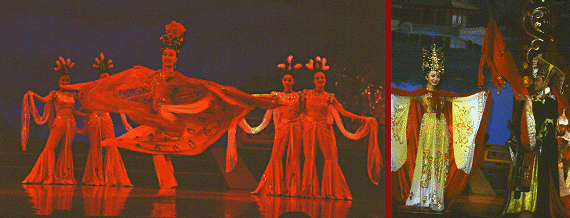
Xian
is also famous for its fabulous food as “the capital of table delicacies”
and of entertainment. As tacky as it sounds, “The Tang Dynasty Dinner Show,”
is actually a lot of fun especially after realizing that the Chinese Opera
screeching music is not a part of the show (of later date than the Tang
Period). With all respect to the uniqueness of the Chinese Opera best experienced
in Beijing, the Tang Show is more catered toward Westerns who can enjoy
similar beautiful attire worn by amazingly skilled artists performing combination
of acting, dancing, singing, acrobatics and mime art. The Beijing Opera
is the must but be thankful that the Chinese entrepreneurs are well aware
of its shrieking/screaming affects on Western tourists and limited it to
less than two hours instead of customary six. On the other hand, one must
always remember that you are in China not to experience what you know but
to enjoy the unknown and unusual. Xian offers both.
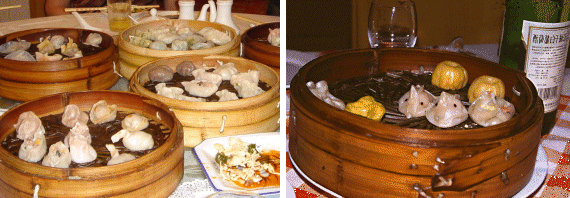
(back
to the map)

While
Chengdu, a capital of Sichuan province, boasts a 2300-year history, its
modern version is too much about bad planning and destruction of all what
was good by replacing it with communist style (or its lack) architecture.
There are still some places worth visiting in an attempt to re-capture
the past of China such as Wenshu Yuan (God of Wisdom Temple)… or to laugh
your head off in the bizarre underground museum of the People’s Park. This
“museum” exhibits, among other things, a life-size statue of Saddam Hussein,
a miniature life-pig (dirty but sweet) and an “artist’s” rendition of American
cowboys, aliens, Indians, Taj Mahal, New York, Rome, etc. I’m still not
sure what was the intended purpose of this Museum but, by default, it became
the Museum of Horror due to “quality” of the exhibit, which makes you laugh
at the weirdest of “artifacts” and their presentation. This is the experience
not to be missed! However, pictures are difficult to take because the “speeding”
train takes you too fast through the darkness of the Halloween “magic”
so only a shark with its bloody teeth, a screaming dinosaur or a dragon,
and an astronaut somehow survived on the film. Anyway, you get an idea…
However,
the biggest attraction of Chengdu is definitely The Giant Panda Breeding
Research Base (ca. 12 km from the city center). Still under construction
since its opening in 1990 this base is to cover more than 230 hectares
to provide these beautiful animals with as much playing and breeding ground
as possible (there are usually 10 to 20 pandas living there).
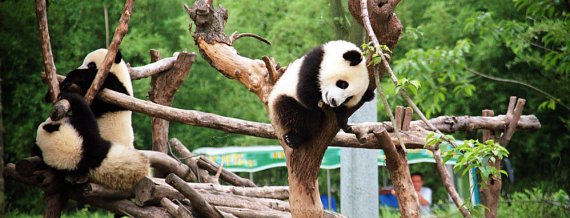
It
is estimated that there are about 1000 pandas still roaming freely in the
southern side of Qinling Mountains, Mingshan Mountains, Qionglai Mountains,
Major-Minor Xiangling Mountains and Liangshan Mountains. Most of their
natural habitat (4/5) is gone “thanks” to modern civilization. The Chengdu
Research Base is the only one that guarantees you a glance at these fantastic
creatures since those which are in other zoos around the world are usually
lonely and sleepy.
The
easygoing giant panda is rather a recluse whose main activity is eating
(mostly bamboos) and sleeping whenever it feels like doing so. Basically,
they are quite lazy, sometimes even too lazy to find a good bed. The panda
shows some energy only as a cub playing with its siblings or as an adult
chasing after the other sex in search of love or lust but always for a
short-term marriage. This happens, the most, once in a year time. However,
pandas can be also quite playful “dressing” up and assuming “seductive”
positions stretching their bodies to relax with “open” bellies “ready to
scratch.” However, I would not recommend this activity since scratching
back can be very painful - long and strong claws are not trimmed on regular
basis and teeth are too sharp for love bites. They behave often as a perfect
lady, sweet and tame, unless they are in danger or on their biological
clock. At other times, when drinking too much fresh water (almost a compulsive
behavior when thirsty), the panda starts staggering like a drunken human
but definitely much cuter. It is believed that the panda drinks so much
of water at one stop because it sees its image in the water and wants to
find its cause.
As
interesting and adored as these animals are, there is still no agreement
how to classify them: some believe that they are related to raccoons (see,
e.g., red panda), others find bears to be their close relatives, and yet
they might be of their very own family. For more information see www.panda.org.cn
In the meantime just enjoy a few pictures of pandas including a red panda,
a very shy and too fast (for a picture) relative of raccoons. They all
share mask-like markings on their faces and cuddly looks.
(back
to the map)

Is
Tibet the lost or forgotten mysterious land of Shangri-La where at the
high altitudes (mostly between 3600 and 5000 m) a hidden community of this
famous lamasery existed in perfect peace and unity with nature? While this
question may never be answered, the truth is that for many Westerners this
is still the place where a spiritual trip might begin or one might be fulfilled.
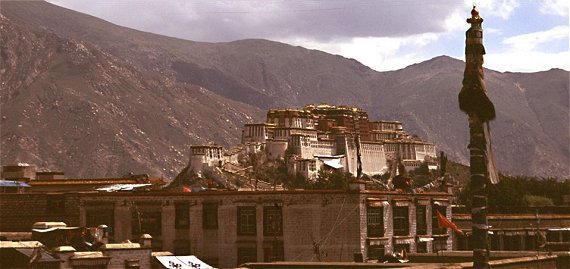
Unfortunately,
its capital, the holy city of Lhasa, is losing its magical powers with
more and more visitors commercializing this - once supposedly ideal - community
since its opening in 1980s. Unfortunately, modern visitors are becoming
more intoxicated with just the fact of being there than with a long history
of its culture and its people struggling against hardships ever present
at this “Rooftop of the World.” Unfortunately, Lhasa is more ethnic
Chinese than native Tibetan (5 to 1) and none of the tourist attractions
might disguise this reality.
There
are many places to see in Lhasa, the city founded in 633 by King Songtsan
who also erected in its center the Jokhang, a shrine of Buddha, for his
Indian wife Princess Bhrikuti. Its most famous feature is the Potala palace
built in the 17th century by Ngawang Lozang Gyatso, and after 1642 the
home of the Dalai Lama who, of course, is no longer there. This thousand-room
structure overlooking the northern part of the city is converted into a
museum with thousands of visitors per day with no room for any spiritual
experience. For some spirituality, you better try other Buddhist sites
such as Norbulingka, summer palace of the Dalai Lama, and several monasteries,
Sera, Drepung, and Nechung located just outside the city (see Lhasa attractions
at www.chinats.com/lhasa).
I must
admit I felt lost among thousands and thousands of Buddhas looking at me
in the darkness of their shrines while I was trying to learn basics about
the Tibetan Buddhism in the crowd of international visitors. Many of them
should not be there because their delicate sense of smell, high altitudes,
and cavalier attitude (“I don’t need any oxygen!”) resulted in throwing
up on the holy floors of numerous shrines - definitely not a spiritual
experience. Others had to try to “sneak” a picture of yet another Buddha
pretending that their expensive cameras actually are worth something in
the lightless conditions of monasteries fogged with offerings of yak butter.
Many complained about anything and everything searching for the lost guides
who were obviously fed up with screaming foreigners and searched for some
peace in the dark niches of the old architectural wonders.
My
pragmatic approach to what was supposed to be a great spiritual experience
must have been noticed by some monks who, instead of granting me everlasting
happiness and health with each and every passing of a “tourist blessing”,
must have cursed me for a shorter period of time. It started with one of
the monasteries where a small hole in the wall is to bring good luck for
eternity as long as you can put your finger into it while walking for approximately
8 m with your eyes closed. Well, I should have known better that with my
luck the hole would have an adverse reaction on me - not only did my finger
found the hole but it did it with such a force that my long fingernail
became its tragic victim, bleeding profusely after half of it ended up
(hopefully not for eternity) in the “luck outlet.” The observing monks
loudly commented on my good fortune, which should have increased with a
beaded bracelet promptly bought in the next shop. To make a long story
short, the bad luck followed me for next two years until the bracelet fell
into pieces in one of not-so-good looking and smelling restrooms in Tehran.
Thus, I can honestly say that my bad luck went down the toilet. Next day,
I was given a true good-luck beaded bracelet from one of my female friends
in Tehran (see
Iran).
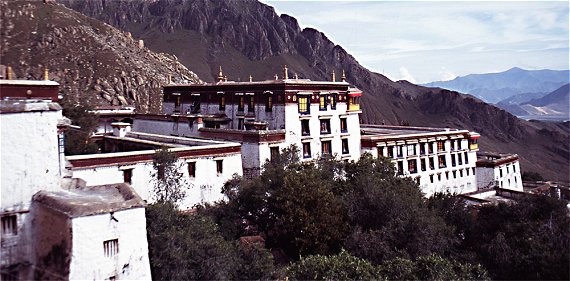
But
back to Tibet… While I failed at discovering any spirituality in me, I
succeeded at discovering kindness, curiosity and beauty of the Tibetan
people. Once I realized that my knowledge of Turkic languages was more
helpful than pretending to speak a few words of Mandarin, I had fantastic
time trying to befriend not only omnipresent entrepreneurs but regular
people enjoying their everyday activities whether visiting a zoo, or trying
to win a price in numerous street contests.
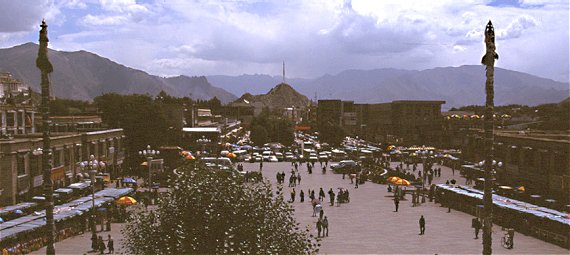
Their
hospitality is so typical of semi-nomadic or nomadic pastoralists whom
I encountered during my other trips (see Kazakhstan,
Kyrgyzstan,
Mongolia,
Uzbekistan).
I wish I could have stayed with them longer to learn more about true Tibet
that just a glimpse at famed monasteries. An important practical advice
- stay away from yak milk in any shape or form!
(back
to the map)

Dunhuang,
one of the most important cities in the history of China, is situated in
the Gansu province, at the edge of the Gobi desert. While the city itself
does not have much to offer except for a new airport opened in August 2002
(I could not help myself - I had to take a few pictures of proud citizens
of Dunhuang welcoming the first plane there and showering startling passengers
with flowers!), it is a great base to visit three major attractions of
the area: the line of watchtowers protecting numerous caravans traveling
across China and beyond; the Buddhist Caves; and the Dunes of the Singing
Sands (Mingsha Shan) with its Crescent Lake.
 |
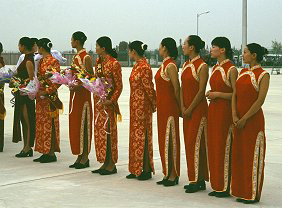 |
The
city was founded in 111 B.C. by Emperor Wudi of the Han dynasty as a military
stronghold on the legendary Silk Road assuring Chinese control over the
routes to the West. The Hsiung-Nu, against whom the Great Wall of China
was built, were among the bravest of the nomads who have bothered China
for thousands of years. They and many others could not have passed such
an easy prey as caravans moving slowly on the fringe of the Gobi and Taklamakan
deserts. Thus, the line of beacons with the Yang Guan Pass (ca 65 km southwest
of Dunhuang) and Yumen Guan Pass (ca 90 km northwest of Dunhuang) was erected
to protect the flow of goods including such valuable commodities as silk,
gold and silver, exotic animals, spices, fragrances, etc.
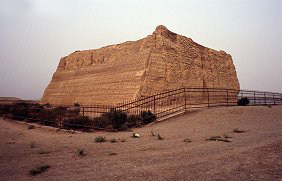 |
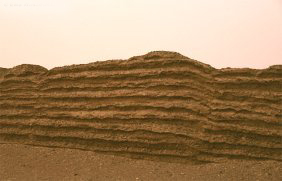 |
There
is not much left of both passes, nor of once impressive walls with their
beacons and signaling towers. The shifting sands of the desert claimed
most of them, the same way as they claimed many caravans and even whole
armies in the past. The blowing wind over broken walls and piles of old
wood and bricks used once to signal danger to those who dared to leave
security of Dunhuang still remind the visitor about those who lost their
lives in this eerie surrounding of nothingness. Those who left the heavenly
empire of China in search of wealth faced hell for many miles to come until
they could reach Kashgar.
Silk,
silver, gold, and other attractions of the West and the East were not the
only goods which were carried on along the Silk Road. From the very beginning
of its existence, the Silk Road was also the main highway for exchanging
ideas and knowledge, sharing experiences and ideologies. The commercial
and intellectual prosperity of Dunhuang attracted people of many different
backgrounds including growing population of Buddhists. By the 4th century
A.D. some of them started to look for more solitude near the Dunes of the
Singing Sands (Mingsha Shan) with its Crescent Lake. With hundreds of tourists
climbing up majestic mountains of sand and sliding down in not so majestic
way, it is hard to imagine that once this place was sought for its spiritual
qualities. The first cave was carved nearby, at a long cliff, Mogaoku,
by a Buddhist monk, Yuezun, searching for solitary meditation high up the
cliff face. Although this one is gone today, it was followed by many similar
caves which were cut, decorated and maintained for the next thousand years
in the area. They overwhelm any visitor with their artistic expressions
in many styles, with the intricate designs and figural presentations telling
stories of the past, present and future, and with enormous amount of Buddhas:
small, huge, carved, painted and sculptured. They are everywhere: the largest
of them is 34.5 meters high and the smallest one is only 2 centimeters
“short.” It is estimated that the artwork of the Mogao caves would cover
25 km of gallery space.
Of
course, one cannot forget about ca. 50 000 manuscripts which once were
stored in the library of these caves. Unfortunately, many of these manuscripts
and paintings have been stolen by foreign travelers and today can be seen
at the best institutions of learning such as the British Museum and the
British Library in London, the Musée Guimet and the Bibliothèque
Nationale in Paris, and the National Museum of India in New Delhi. They
are the most important resources for studying not only the history of Buddhism
and Buddhist art, but also of cultural, social, economic, and even political
history of the area. In many ways, the Dunhuang caves seem to be more spiritual
and more “Buddhist” in their nature than monasteries of Lhasa. However,
I still believe that the true soul of this region is to be found in the
ghastly remains of old walls and beacons deep into the desert rather than
in artistic visions of the Buddhist monks. On the other hand, they complement
each other beautifully.
(back
to the map)

Only
a very few people would recommend a trip to Urumchi as a tourist destination
since the only “attraction” of this city seems to be drab stalinisque type
of concrete architecture that can be seen in any communist country. However,
this city is an important crossroad for seeing true attractions of the
Xinjiang province where different Turkic languages are spoken and the Middle
Eastern food competes with Chinese dishes. There is only one thing worth
seeing in Urumchi - its Museum which contains one of the best-preserved
and unusual mummies in the world. This is the reason why I was desperate
to see the city.
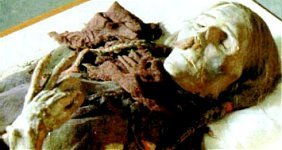 |
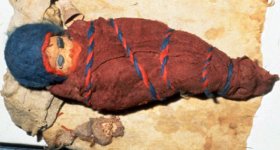 |
Tarim
Basin Mummies (also known as Urumchi/Taklamakan/Chinese mummies) have been
found by Chinese archaeologists in 1970s but, for various reasons, this
discovery has been one of the best-kept secrets until 1988 when Professor
Victor Mair visited this Museum. He was simply astounded to find there
not only perfectly preserved mummies but mostly because they looked Caucasian,
not Chinese. These Caucasoid mummies have been reported by European travelers
such as Aurel Stein in previous centuries but due to their remarkable state
of preservation they were thought to be quite modern. Imagine everyone’s
surprise when, after research initiated by Dr. Mair, it appeared that the
oldest mummies can be dated as early as ca. 2000 B.C.
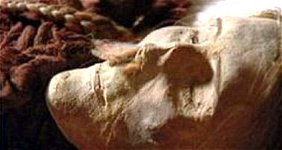 |
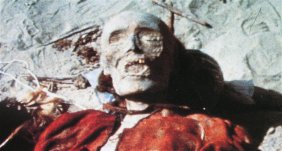 |
The
Taklamakan Desert, where these mummies have been found, is one of the most
ferocious deserts in the world. People who have been living on its peripheries
have been aware that many towns, caravans etc. have disappeared under the
sand due to terrible sand storms and unpredictable geographical conditions
influenced by high mountain ranges (Tien Shan to the north, Kunlun Mountains
to the south, Pamirs to the west) surrounding it. They have lived very
modest lives by cultivating wheat and millet, and herding cattle, sheep,
and goats. As many Indo-European and Altaic people of the region they could
have been originally pastoralists who cherished their horses. When they
died, they were buried in different types of tombs (depending on the time
period) with majority of them seemingly constructed in such a way as to
facilitate process of natural mummification (shallow graves, bottomless
coffins, wooden planks, etc.). Human interference in preservation of these
mummies can also be seen in the use of some fatty substances to probably
work as an anti-bacterial agent and, in one case of a horse burial, removal
of a bone from foreleg in order to stuff the skin with reeds.
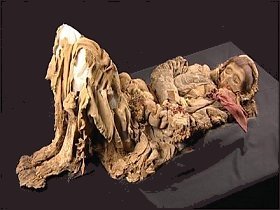 |
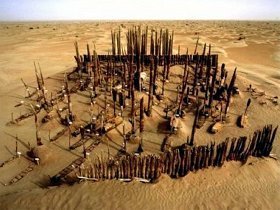 |
These
Caucasoid looking mummies have blond, red and light brown hair with facial
features similar to those of the ancient Celts and other Indo-European
speaking people who were of the same origin. Some of them had body decorations
(tattoos, paintings, etc.), many were fond of their clothes, especially
long conical hats. It is very interesting that their weaving techniques
are quite similar to those found among the Celts hundreds years later in
Europe. Most of them seem to die of natural death but there are others
who were terribly mistreated with body mutilations, gouged eyes, and even
buried alive (“The Scream Baby”).
It
is believed that they were speaking one of Indo-European languages and
the best candidate is the Tocharian language (actually there are two dialects
to this language) recorded by the Buddhist monks of the area in much later
period. This language is similar to the oldest Indo-European language recorded
in writing (cuneiform) - the Hittite language of Anatolia in the second
millennium B.C. One of the most recent discoveries with mummies is
a cemetery known as the Xiaohe Tombs in Lop Nur. Since I was not allowed
to take pictures, the enclosed images are a small selection from various
Internet sources.
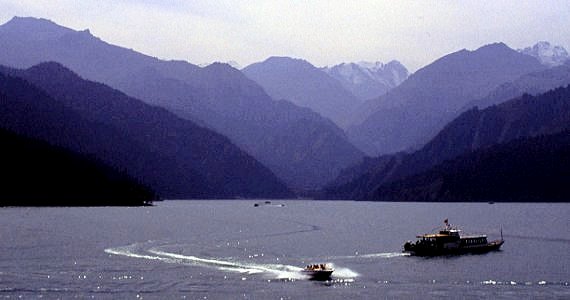
One
day at Urumchi, just to see the mummies, is more than enough. Pack your
bags and travel toward the east (I had to miss Kashgar to the west). For
a leisurely time and some hiking, boating etc., you can stop at Tian Chi
- a beautiful small, deep-blue lake with Tien Shan (Heavenly) Mountains
in the distance. Here, nomadic yurts and friendly Turkic people welcome
any guests for short and long visits. However, your destination point should
be Turpan and its surrounding. I totally fell in love with Turpan County
inhabited mostly by the Uighurs (another group of Turkic people) who enjoy
seemingly worry-free life in this hottest place in China. This is where
the best of China meets the best of the Turkic nomads, and both of them
are “served” on nomadic carpets with grapes hanging everywhere and red
wine flowing freely with every meal.
You
can visit a small, Middle Eastern looking bazaar (a miniature of the famous
one at Kashgar), or you can have a short trip to admire Emin Hoja Minaret
built in 1777 with its intricacy of 15 different brick patterns to make
this simple Afghani style minaret more interesting and better fitting into
spectacular environment of the Tien Shan mountains and the Flaming Mountains
nearby.
Stay
longer and you can see the Gaochang ruins where, in the 9th century, the
Uighur established the capital of their Karakhoja kingdom after leaving
Mongolia (see Mongolia for more information).
This city was erected already in the 1st c. B.C. when it became a very
important stop on the Silk Road. Some of its inhabitants were buried in
the Asitana tombs nearby (only 3 are open for tourists) and are very well
mummified. The city is well preserved but you need a guide or a good map
in order to recognize various structures within.
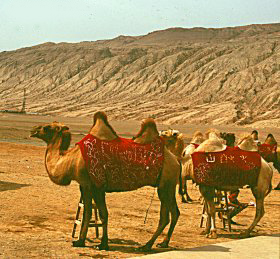 |
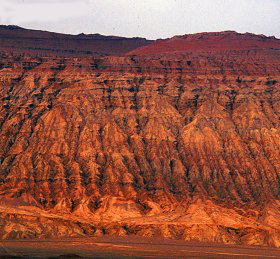 |
On
the way from Gaochang to the Bezeklik Caves don’t forget to stop and admire
the Flaming Mountains. “The Flaming part” can only be seen in the morning
which is a great time to visit this place before local entrepreneurs with
their camels show up to “handle” a few “lost” tourists. According to the
Chinese legend from the Ming Dynasty, the Monkey King kicked off the oven
and charcoals fell from the heaven to the Turpan Basin creating the Flaming
Mountains. However, I prefer the Uighur story of the horrible dragon who
demanded little children (or young virgins - both males and females) as
his choice of food. Needless to say, an Uighur hero was able to kill the
monster whose blood colored the mountains and eight scars of the mutilated
dragon are now valleys in the Flaming Mountains. The Grape Valley is the
one which represents almost paradisiacal existence (don’t pick the grapes
unless you are prepared to pay heavy fines!) for me. Here, you can enjoy
huge variety of different grapes, fresh and dry (raisins), and visit one
of the most important invention of humankind - the karez (qanat) irrigation
system.
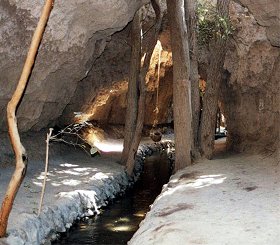 |
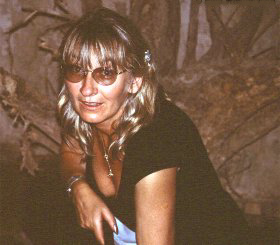 |
Both
the Persians and the Chinese claim its discovery some time in the first
millennium B.C. but the one in Xinjiang is the most complete, stretching
at its best for over 5000 km. The karez system is constructed in such a
way as to extract groundwater in the dry mountain basins - here melting
snow of Tien Shan. Vertical wells are to collect water, provide ventilation
and access for necessary repairs. They might be as deep as 100 meters and
are connected at their bottoms through underground canals distributing
water from high to low grounds (using gravity) to finally bringing it up
to irrigation channels of the fields. No need for pumps and always
nice, cool place to run away from the heat of the desert!
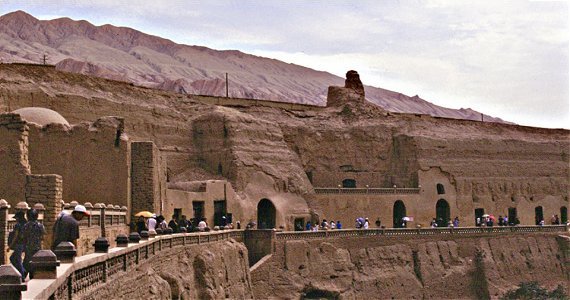
Bezeklik
Thousand Buddha Caves on the cliffs of the Mutou Valley were the Buddhist
center for the city of Gaochang. Unfortunately, 57 caves that are still
there (over 80 original caves) have been very much destroyed by vandals
of the last seven centuries and many murals were removed to the West, particularly
to Germany by Albert von Le Coq. The remaining ones are still worth visiting
in the beautiful scenery of the valley in order to be prepared to a trip
to Dunhuang.
An
ancient city of Jiaohe (Yarkhoto), marketed by local guides as “the best
preserved earthen city in the world,” is yet another worthy destination
of Turpan valleys. It stands on an island between two rivers as a garrison
town established during the Han dynasty to defend the borderlands. At one
point, Jiaohe was home to 6500 residents and 865 soldiers.
The
city was finally abandoned at the beginning of the 14th century since it
had never recovered from its devastation by the most famous nomad of them
all: Chenghiz Khan. Its ruins are more pronounced that the ones of Gaochang
so enjoy a long stroll through old streets, residences and temples.
(back
to the map)
| .. |
|
 |
NOTES:
Most of the pictures are taken and copyrighted by Ewa Wasilewska, a few
(e.g., mummies, carpets, artifacts, banner photos) have been borrowed for
educational purposes from different Internet sites. |
| .. |
|
 |
Basic
information about China |
|

